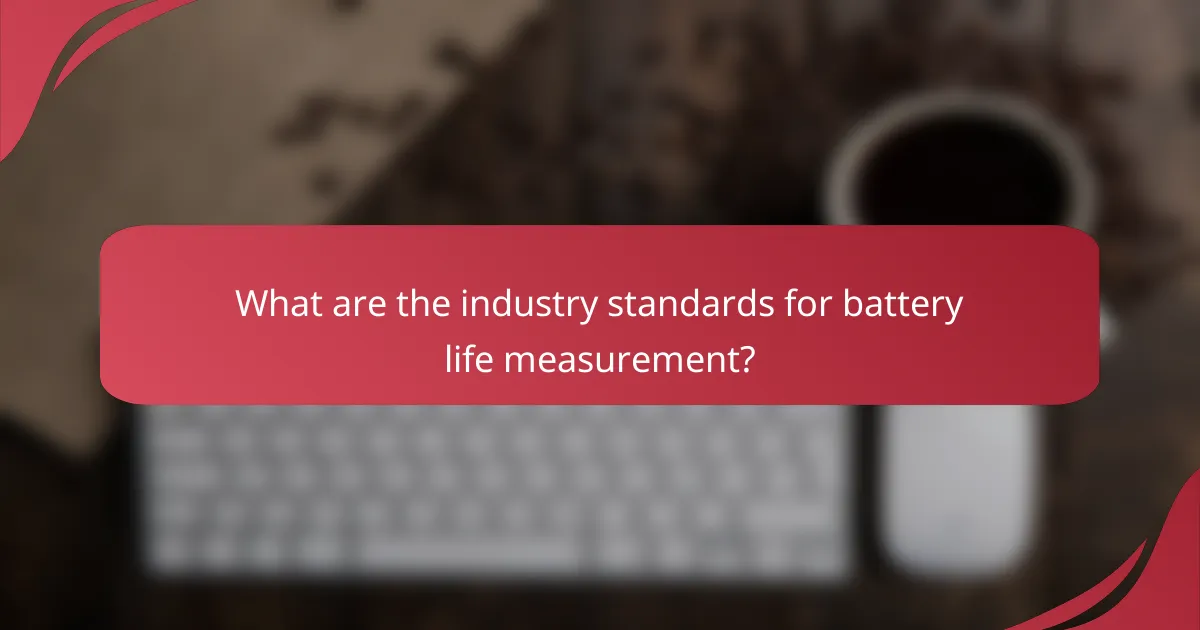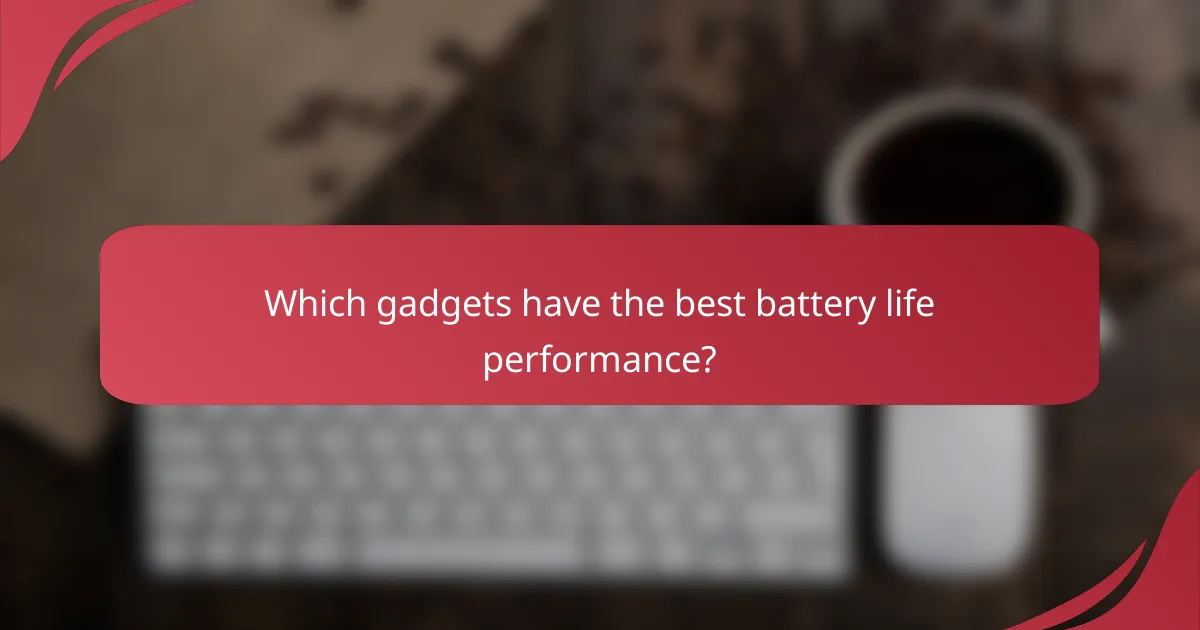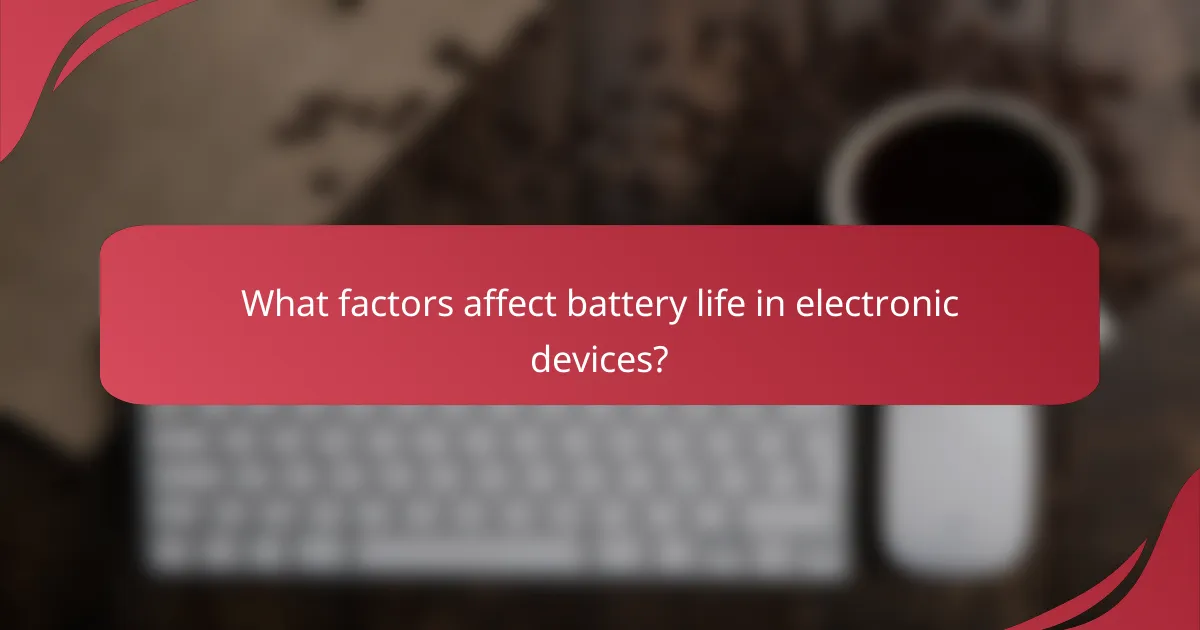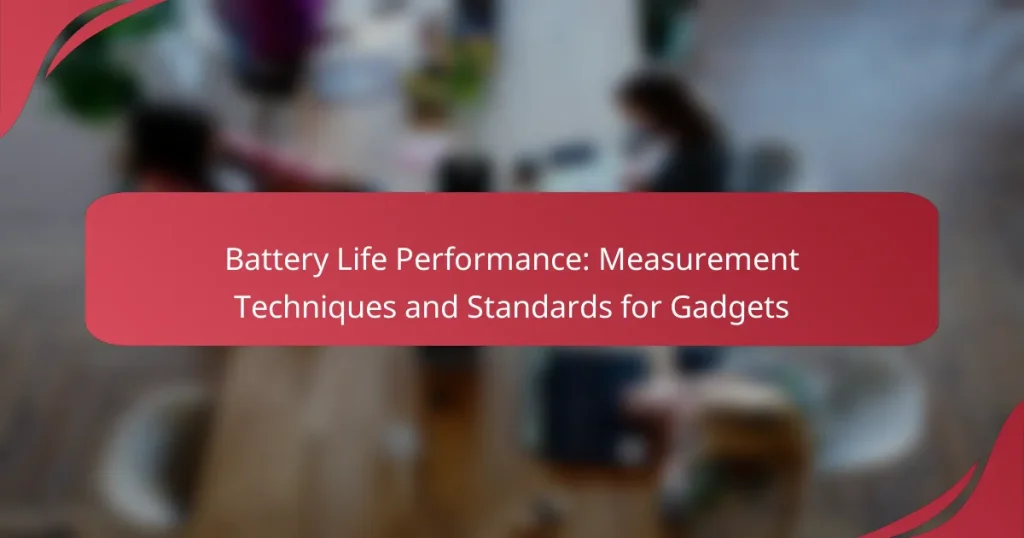Battery life performance is a critical aspect of gadget usability, requiring precise measurement techniques to evaluate how long devices can operate under different conditions. By adhering to industry standards, manufacturers can provide consistent and accurate assessments of battery longevity, helping consumers make informed choices. High-performing gadgets, such as flagship smartphones and gaming devices, exemplify the importance of efficient power management in enhancing user satisfaction.

How to measure battery life performance in gadgets?
Measuring battery life performance in gadgets involves assessing how long a device operates under various conditions. This can be achieved through several methods, including controlled tests and real-world usage scenarios.
Battery discharge tests
Battery discharge tests involve fully charging a device and then using it until the battery is depleted. This method provides a clear measurement of the total runtime under specific conditions, such as screen brightness and application usage. It’s crucial to conduct these tests multiple times to account for variability in battery performance.
When performing discharge tests, consider using standardized settings to ensure consistency. For example, keeping the screen brightness at a fixed level and using the same applications can yield more reliable results.
Real-world usage simulations
Real-world usage simulations aim to replicate everyday scenarios that users encounter. This method often combines various tasks, such as browsing, streaming, and gaming, to reflect typical usage patterns. By simulating real-life conditions, you can gain insights into how a gadget performs in practical situations.
To create effective simulations, gather data on common usage habits and incorporate them into your tests. This approach helps identify potential battery drain issues that might not appear in controlled tests.
Manufacturer specifications
Manufacturer specifications provide baseline information about a gadget’s battery life, often expressed in hours for specific tasks like video playback or web browsing. While these figures can be useful, they may not always reflect real-world performance due to variations in user behavior and settings.
When evaluating specifications, look for independent reviews and tests that validate the manufacturer’s claims. This can help you better understand how the device might perform in your own usage scenarios.
Battery benchmarking tools
Battery benchmarking tools are software applications designed to evaluate battery performance under various conditions. These tools can measure metrics such as discharge rates, charging times, and overall efficiency. Popular options include GFXBench and PCMark, which provide standardized tests for comparison.
Using benchmarking tools can help identify discrepancies between expected and actual battery performance. Regularly updating these tools ensures you have the latest testing methodologies and can provide more accurate results.

What are the industry standards for battery life measurement?
Industry standards for battery life measurement provide guidelines to ensure consistency and accuracy in evaluating battery performance across various devices. These standards help manufacturers and consumers understand battery longevity and efficiency in practical terms.
IEC 61960 standard
The IEC 61960 standard outlines the testing methods for lithium-ion batteries, focusing on capacity, performance, and safety. It specifies how to measure the energy capacity of batteries under specific conditions, ensuring that results are comparable across different manufacturers and devices.
This standard is crucial for consumer electronics, as it helps users gauge the expected battery life of devices like smartphones and laptops. Adhering to IEC 61960 can enhance consumer trust in battery specifications.
IEEE 1725 standard
The IEEE 1725 standard addresses the testing and evaluation of rechargeable batteries used in portable consumer electronics. It emphasizes the need for comprehensive testing to assess battery performance under various conditions, including temperature and charge cycles.
This standard helps manufacturers identify potential issues that could affect battery life, such as thermal runaway or capacity fade. By following IEEE 1725, companies can improve the reliability and safety of their products.
Mobile Industry Processor Interface (MIPI) standards
The MIPI standards focus on the interface between mobile devices and their components, including battery management systems. These standards ensure that devices can efficiently communicate with batteries to optimize performance and longevity.
By implementing MIPI standards, manufacturers can enhance battery life through better power management techniques, such as adaptive charging and discharge rates. This leads to improved user experiences and longer-lasting devices.

Which gadgets have the best battery life performance?
Gadgets with the best battery life performance typically include flagship smartphones and gaming devices known for their efficient power management. Devices like the Apple iPhone 14 Pro Max, Samsung Galaxy S23 Ultra, and Asus ROG Phone 6 stand out for their longevity and user satisfaction in daily use.
Apple iPhone 14 Pro Max
The Apple iPhone 14 Pro Max is renowned for its impressive battery life, often lasting over a day with moderate usage. Its efficiency stems from the A16 Bionic chip, which optimizes power consumption while delivering high performance.
Users can expect around 20-25 hours of talk time and up to 80 hours of audio playback. To maximize battery longevity, consider enabling Low Power Mode during critical times and managing background app refresh settings.
Samsung Galaxy S23 Ultra
The Samsung Galaxy S23 Ultra features a robust battery that can sustain heavy usage throughout the day, often exceeding 24 hours on a single charge. This is largely due to its adaptive battery technology that learns user habits to conserve energy.
With a capacity of around 5,000 mAh, it supports fast charging and wireless charging options. To enhance battery performance, users should regularly update their software and limit the use of high-resolution displays when not needed.
Asus ROG Phone 6
The Asus ROG Phone 6 is designed for gamers, boasting a massive battery that can last up to 12 hours during intensive gaming sessions. Its 6,000 mAh capacity allows for extended play without frequent recharges.
This device features various gaming modes that optimize performance while managing power consumption. To get the most out of the battery, users should utilize the built-in battery optimization settings and avoid running multiple demanding applications simultaneously.

What factors affect battery life in electronic devices?
Battery life in electronic devices is influenced by several key factors, including screen brightness, app usage, and network connectivity. Understanding these elements can help users optimize their device’s performance and extend battery longevity.
Screen brightness settings
Screen brightness is a significant factor affecting battery life, as higher brightness levels consume more power. Users can save battery by adjusting brightness to a lower level or enabling adaptive brightness, which automatically adjusts based on ambient light conditions.
For example, reducing screen brightness by 20-30% can lead to noticeable improvements in battery performance, especially during prolonged use. Consider using dark mode on OLED screens, as it can further conserve energy by turning off pixels in dark areas.
App usage patterns
The way apps are used directly impacts battery life. Apps that run in the background, such as social media or location services, can drain power even when not actively in use. Monitoring app activity and closing unused applications can help mitigate this issue.
To optimize battery life, users should regularly check battery usage statistics in device settings. Limiting high-drain apps or scheduling their use during charging times can significantly extend overall battery performance.
Network connectivity
Network connectivity plays a crucial role in battery consumption, with Wi-Fi generally being more efficient than cellular data. When devices constantly search for a signal or switch between networks, battery life can diminish rapidly.
To conserve battery, users should turn off mobile data when Wi-Fi is available and disable features like Bluetooth or GPS when not in use. Additionally, enabling airplane mode in low-signal areas can prevent excessive battery drain from searching for connections.

How can users extend battery life in their gadgets?
Users can extend battery life in their gadgets by optimizing settings, utilizing battery saver modes, and keeping software up to date. These strategies can significantly reduce power consumption and enhance overall device longevity.
Optimizing settings
Adjusting device settings is a straightforward way to improve battery life. Lowering screen brightness, reducing screen timeout duration, and disabling unnecessary background apps can lead to noticeable energy savings.
Consider turning off features like Bluetooth, Wi-Fi, and location services when not in use. These functions consume power even when idle, so disabling them can extend battery life by several hours.
Using battery saver modes
Most gadgets come equipped with battery saver modes designed to minimize power usage. Activating these modes can automatically adjust settings, such as limiting background data and reducing performance, to conserve energy.
Users should familiarize themselves with their device’s specific battery saver features, as some may offer customizable options. Engaging these modes during critical times can help stretch battery life significantly.
Regular software updates
Keeping software up to date is essential for optimal battery performance. Manufacturers often release updates that include enhancements to power management and efficiency, which can directly impact battery longevity.
Users should regularly check for updates and install them promptly. This practice not only improves battery life but also enhances security and device functionality.

What are the differences between lithium-ion and lithium-polymer batteries?
Lithium-ion and lithium-polymer batteries differ primarily in their construction and performance characteristics. Lithium-ion batteries use a liquid electrolyte, while lithium-polymer batteries utilize a gel-like or solid polymer electrolyte, which affects their size, weight, and energy density.
Energy density comparison
Energy density refers to the amount of energy stored per unit of weight or volume. Lithium-ion batteries typically have a higher energy density, ranging from 150 to 250 Wh/kg, making them suitable for applications where weight is critical, such as smartphones and laptops.
In contrast, lithium-polymer batteries generally offer lower energy densities, around 100 to 200 Wh/kg. However, their flexible form factor allows for thinner designs, which can be advantageous in compact devices. The choice between the two often depends on the specific requirements of the gadget.


